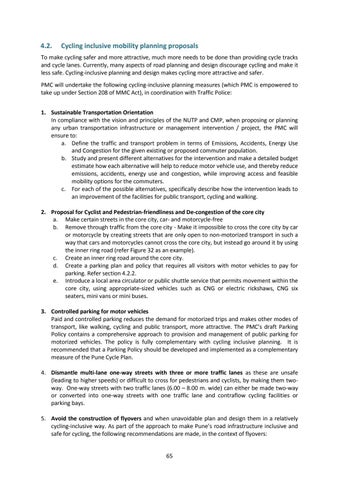4.2.
Cycling inclusive mobility planning proposals
To make cycling safer and more attractive, much more needs to be done than providing cycle tracks and cycle lanes. Currently, many aspects of road planning and design discourage cycling and make it less safe. Cycling-inclusive planning and design makes cycling more attractive and safer. PMC will undertake the following cycling-inclusive planning measures (which PMC is empowered to take up under Section 208 of MMC Act), in coordination with Traffic Police: 1. Sustainable Transportation Orientation In compliance with the vision and principles of the NUTP and CMP, when proposing or planning any urban transportation infrastructure or management intervention / project, the PMC will ensure to: a. Define the traffic and transport problem in terms of Emissions, Accidents, Energy Use and Congestion for the given existing or proposed commuter population. b. Study and present different alternatives for the intervention and make a detailed budget estimate how each alternative will help to reduce motor vehicle use, and thereby reduce emissions, accidents, energy use and congestion, while improving access and feasible mobility options for the commuters. c. For each of the possible alternatives, specifically describe how the intervention leads to an improvement of the facilities for public transport, cycling and walking. 2. Proposal for Cyclist and Pedestrian-friendliness and De-congestion of the core city a. Make certain streets in the core city, car- and motorcycle-free b. Remove through traffic from the core city - Make it impossible to cross the core city by car or motorcycle by creating streets that are only open to non-motorized transport in such a way that cars and motorcycles cannot cross the core city, but instead go around it by using the inner ring road (refer Figure 32 as an example). c. Create an inner ring road around the core city. d. Create a parking plan and policy that requires all visitors with motor vehicles to pay for parking. Refer section 4.2.2. e. Introduce a local area circulator or public shuttle service that permits movement within the core city, using appropriate-sized vehicles such as CNG or electric rickshaws, CNG six seaters, mini vans or mini buses. 3. Controlled parking for motor vehicles Paid and controlled parking reduces the demand for motorized trips and makes other modes of transport, like walking, cycling and public transport, more attractive. The PMC’s draft Parking Policy contains a comprehensive approach to provision and management of public parking for motorized vehicles. The policy is fully complementary with cycling inclusive planning. It is recommended that a Parking Policy should be developed and implemented as a complementary measure of the Pune Cycle Plan. 4. Dismantle multi-lane one-way streets with three or more traffic lanes as these are unsafe (leading to higher speeds) or difficult to cross for pedestrians and cyclists, by making them twoway. One-way streets with two traffic lanes (6.00 – 8.00 m. wide) can either be made two-way or converted into one-way streets with one traffic lane and contraflow cycling facilities or parking bays. 5. Avoid the construction of flyovers and when unavoidable plan and design them in a relatively cycling-inclusive way. As part of the approach to make Pune’s road infrastructure inclusive and safe for cycling, the following recommendations are made, in the context of flyovers:
65















